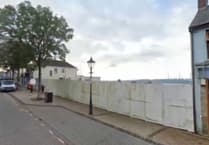A scientific study to help developers pinpoint the best sites for tidal turbines has been put through its paces at Wales’ National Marine Test Site, META, in the Milford Haven waterway.
During a month-long trial by Swansea University, a full-scale triangular-framed device was lowered to the seabed to measure the speed of the current.
Traditional instruments rely on diverging beams to measure peak flow velocity, but researchers led by Professor Ian Masters and his team modified the design to create a converging acoustic doppler current profiler (C-ADCP). Each arm of the triangular frame was mounted with specialist sensors.
By emitting converging beams they captured far higher quality data.
Ian Masters, Professor of Ocean Energy at Swansea University, said: “When we really understand the tidal velocity and the way it changes with turbulence from one second to the next, we can use that information to design high performance and economic tidal turbines. This will reduce our dependence on oil and gas imports.”
Boasting eight easy to access test sea sites in and around the Milford Haven waterway, Wales’ National Test Centre META was chosen for the trials because it offers the best opportunity to rigorously assess innovative technology at an early stage.
Tom Hill, META Project Delivery Manager said: “We already have all the necessary consents in place and were able to make all the introductions and deployment planning Swansea University needed, allowing them to focus on the detail.”
The (C-ADCP) device is one of several open-source tools to come out of an EU Ireland-Wales funded alliance known as SELKIE. The project sees industry and academia collaborating on the innovative solutions needed to propel the marine energy industry forward.
With growing momentum behind the net zero carbon emissions, Wales is set to become a hub for marine renewable energy.
The META testing site is a key asset of the wider Pembroke Dock Marine Project – a £60.5 million investment aimed at drawing skills, facilities and infrastructure into the region to grow Wales’ low carbon economy.





Comments
This article has no comments yet. Be the first to leave a comment.